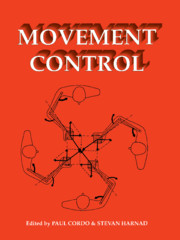Book contents
- Frontmatter
- Contents
- Preface
- 1 Does the nervous system use equilibrium-point control to guide single and multiple joint movements?
- 2 Does the nervous system depend on kinesthetic information to control natural limb movements?
- 3 Can sense be made of spinal interneuron circuits?
- 4 Implications of neural networks for how we think about brain function
- 5 Do cortical and basal ganglionic motor areas use “motor programs” to control movement?
- 6 Functional heterogeneity with structural homogeneity: How does the cerebellum operate?
- 7 Are movement parameters recognizably coded in the activity of single neurons?
- 8 The representation of egocentric space in the posterior parietal cortex
- Open Peer Commentary and Authors' Responses
- References
- Index
5 - Do cortical and basal ganglionic motor areas use “motor programs” to control movement?
Published online by Cambridge University Press: 11 December 2009
- Frontmatter
- Contents
- Preface
- 1 Does the nervous system use equilibrium-point control to guide single and multiple joint movements?
- 2 Does the nervous system depend on kinesthetic information to control natural limb movements?
- 3 Can sense be made of spinal interneuron circuits?
- 4 Implications of neural networks for how we think about brain function
- 5 Do cortical and basal ganglionic motor areas use “motor programs” to control movement?
- 6 Functional heterogeneity with structural homogeneity: How does the cerebellum operate?
- 7 Are movement parameters recognizably coded in the activity of single neurons?
- 8 The representation of egocentric space in the posterior parietal cortex
- Open Peer Commentary and Authors' Responses
- References
- Index
Summary
Abstract: Prevailing engineering-inspired theories of motor control based on sequential/algorithmic or motor-programming models are difficult to reconcile with what is known about the anatomy and physiology of the motor areas. This is partly because of certain problems with the theories themselves and partly because of features of the cortical and basal ganglionic motor circuits that seem illsuited for most engineering analyses of motor control. Recent developments in computational neuroscience offer more realistic, that is, connectionist, models of motor processing. The distributed, highly parallel, and nonalgorithmic processes in these models are inherently self-organizing and hence more plausible biologically than their more traditional algorithmic or motor-programming counterparts. The newer models also have the potential to explain some of the unique features of natural, brain-based motor behavior and to avoid some of the computational dilemmas associated with engineering approaches.
- Type
- Chapter
- Information
- Movement Control , pp. 54 - 63Publisher: Cambridge University PressPrint publication year: 1994
- 3
- Cited by



